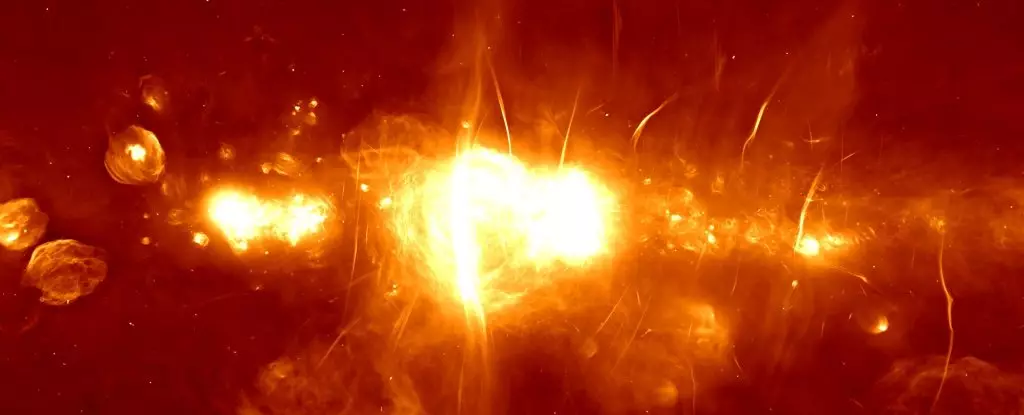In a remarkable advancement in our understanding of the Milky Way, astronomers have unveiled a new phenomenon nestled within the chaotic expanse of the Central Molecular Zone (CMZ). This region, which encircles our galaxy’s supermassive black hole, has long been a subject of intrigue due to its unique environment of dense gas and cosmic activity. Recently, astronomers led by Kai Yang from Shanghai Jiao Tong University have identified novel long, slender filaments of gas, likened to cosmic tornadoes, which mark a significant shift in our comprehension of gas dispersal mechanisms in this enigmatic area.
This groundbreaking finding challenges existing paradigms within astrophysics and opens up a myriad of questions regarding the driving forces behind these chaotic structures. Such discoveries not only reshape our understanding of the Milky Way’s morphology but also contribute to the broader context of galactic evolution.
The Turbulent Nature of the Central Molecular Zone
The CMZ is a tumultuous region that spans approximately 2,000 light-years, filled with clouds rich in dust and molecular gas. Its density is remarkable—comprising nearly 80% of the galaxy’s dense gas and around 5% of its molecular gas. Within this wild environment, gas clouds collide and interact at astonishing velocities, creating an atmosphere marked by shock fronts and turbulence. Here, the universe showcases its raw power, with clouds racing through space at speeds reaching 100 kilometers per second.
However, the sheer density of these clouds has historically complicated our observations, leading researchers to rely on advanced technologies to peer into this cosmic chaos. The Atacama Large Millimeter/submillimeter Array (ALMA) in Chile provided unprecedented access to this dense region, enabling astronomers to trace the presence of vital gases like silicon monoxide, which helps delineate shock waves.
The Discovery of Slim Filaments
During their observations, the research team stumbled upon a surprising category of structures they dubbed “slim filaments.” These structures are characterized by their long and narrow form, distinctly different from any astrophysical objects observed previously in the galaxy. In addition to silicon monoxide, the slim filaments harbor a plethora of complex organic molecules, including formaldehyde and methanol, creating a rich tapestry of chemical interactions within these turbulent gas streams.
The velocity distributions associated with these slim filaments are markedly different from the more established filaments observed in other regions, hinting at their unique dynamic interactions. This turbulent pressure dominance suggests a striking analogy to terrestrial tornadoes and dust devils, which are known for their capacity to efficiently transport and redistribute materials across their environment.
According to astronomer Xing Lu of the Shanghai Astronomical Observatory, the emergence of these structures underscores their significance in the material dynamics of the CMZ. They may play an essential role in the ecological turnover of gas and dust, much like the cycles found in nature, allowing essential elements to circulate and replenish the interstellar medium.
The Role of Shock Waves in Filament Formation
As researchers dive deeper into the mechanics behind the formation of slim filaments, they begin to form hypotheses about the underlying processes. Initial analysis suggests that shock waves, resulting from collisions between gas clouds, may initiate the genesis of these turbulent structures. Such shocks could elevate complex molecules into a gaseous state, releasing them into the CMZ and paving the way for their transformation back into dust as they cool.
The researchers speculate that the presence of these slim filaments could substantially influence the recycling rate of material in the CMZ, thus redefining our understanding of cosmic evolution within this dynamic region. If the findings from their observation sample hold true across the CMZ, these cosmic tornadoes might serve as the linchpins for material circulation, facilitating a continual redistribution of vital components necessary for star formation and the nurturing of life.
Implications for Galactic Dynamics
The implications of discovering slim filaments extend far beyond the confines of the Milky Way. They invoke broader questions about galactic dynamics and material recycling in various cosmic environments, including other galaxies with analogous structures. This research emphasizes the interconnectedness of cosmic phenomena and the wonderful complexity of the universe we inhabit.
As these findings challenge our existing notions of gas behavior in dense environments, they are likely to lead to a reevaluation of models describing gas dynamics throughout the universe. Researchers and astronomers will need to integrate these new insights into the broader framework of astrophysics, ultimately enriching our understanding of how galaxies evolve and interact.
In the vast cosmic dance of creation and destruction, slim filaments offer an exciting glimpse into the unseen mechanisms at play, reminding us of the ever-unfolding mysteries of the universe and our quest to comprehend them.

